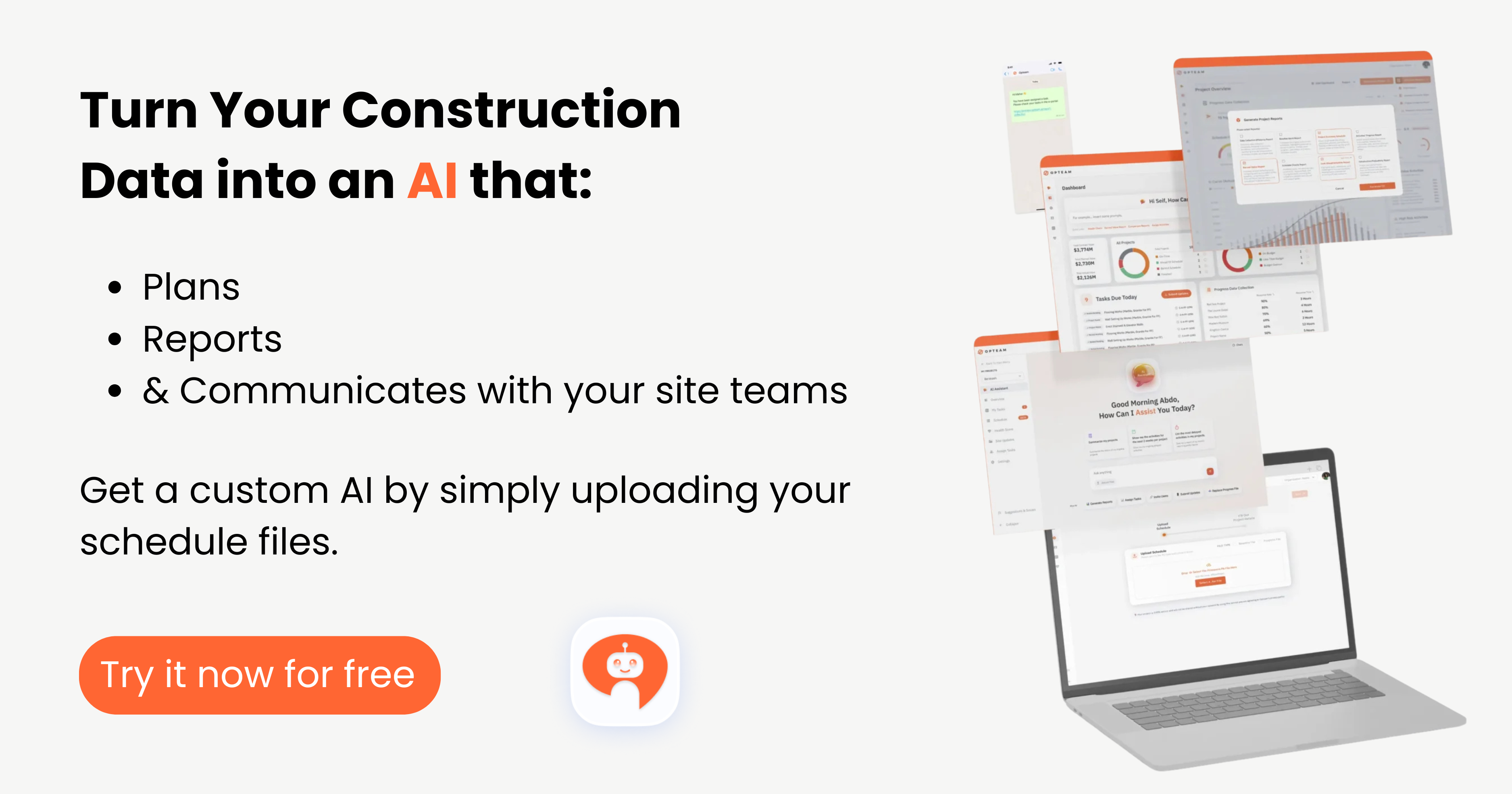In 2025, the best project controls softwares in construction can be summarized in this list:
1- Opteam
2- Asta Powerproject
3- Procore
4- Aconex (Oracle)
5- Deltek Acumen
6- Tilos
7- Safran Project
8- InEight
9- Hexagon EcoSys
10- Newforma
1- Opteam
Construction projects move fast. But progress data? It’s scattered across P6 files, Excel sheets, PDFs, PowerPoint slides, and endless email threads.
Opteam brings it all together, so consultants and contractors can finally see the full picture.
For Consulting Companies
Opteam helps consulting companies compare baseline vs actual progress, track progress, flag delays and generate reports in real-time without wasting hours on manual processes.
Instead of manually comparing what was planned vs what’s actually happening on site, Opteam gives you clear visual reports that show real progress, broken down by work packages, activities, or trades.
You can instantly spot gaps, generate client-ready reports, and have solid backup for every recommendation.
For Contracting Companies
Opteam helps you stay in control of the narrative. Whether you’re working with weekly P6 updates, site diaries, or Excel logs, the platform turns your fragmented data into clear, visual progress reports.
Use it to show planned vs actual, identify bottlenecks, and push back on unfair delay claims with real proof.
Forget copy-pasting into PowerPoint or wrangling with Excel formulas — Opteam builds the reports for you.
So your team can focus on delivering, not documenting.
👉 Book your live demo and see how Opteam fits your project workflow, whether you’re tracking progress or proving it.
2- Asta Powerproject
Asta Powerproject is designed specifically for construction scheduling and is popular in the UK and Europe. It supports 4D planning, quantity tracking, and resource management — with features tailored to subcontractor workflows.
Its visual interface is more intuitive than P6, and it’s easier to generate stakeholder-friendly timelines, though it’s still mostly used for planning rather than progress tracking or claims.
3- Procore
Procore is a comprehensive construction management platform covering everything from drawings and RFIs to submittals, budgets, and daily logs. It’s especially strong on-site, with a solid mobile app and field-first features.
While it offers some scheduling and reporting tools, many firms still use Procore alongside Primavera or MS Project for full schedule control and analysis.
4- Aconex (Oracle)
Aconex, also owned by Oracle, is a document control and communication platform widely used on large-scale construction projects. It helps teams manage RFIs, transmittals, and workflows in a secure and audit-friendly way.
It’s not a scheduling tool by itself, but it plays a crucial role in keeping information flowing between stakeholders — especially across complex, multi-party projects.
5- Deltek Acumen
Deltek Acumen is built for schedule diagnostics, risk analysis, and forensic delay evaluation. It works alongside P6 or MS Project to analyze schedule quality and simulate “what-if” scenarios.
Consultants and claims experts use Acumen to validate baseline schedules, assess float paths, and strengthen the defensibility of EOT submissions or delay analyses.
6- Tilos
Tilos is purpose-built for linear infrastructure projects like roads, pipelines, and railways. It combines time and distance into a single visual plan — perfect for showing work fronts across geography.
It’s heavily used in civil engineering and transport projects, and is often paired with P6 to provide a more intuitive view of linear construction progress.
7- Safran Project
Safran Project focuses on high-precision scheduling, cost, and risk management. It’s particularly strong in oil & gas, offshore, and energy projects that require robust scenario planning and risk analysis.
With native support for uncertainty modeling and Monte Carlo simulations, it’s a go-to tool for planners who need to forecast outcomes across multiple risk scenarios.
8- InEight
InEight offers an integrated platform that spans estimating, scheduling, cost control, and field execution. It’s aimed at owners and EPC firms managing large capital projects.
Its strength lies in combining budgets, forecasts, and progress tracking into one environment — giving project controls teams better visibility into both time and cost performance.
9- Hexagon EcoSys
EcoSys by Hexagon is an enterprise-level solution for project cost control, earned value management (EVM), and capital planning. It’s used by large organizations to manage budgets, forecasts, and KPIs across portfolios.
While it’s not a scheduling tool like P6, it integrates with them to give leadership visibility over project performance and financial health in real time.
10- Newforma
Newforma is primarily focused on project information management — organizing submittals, RFIs, meeting minutes, and document workflows across teams. It’s especially popular among architects and engineering consultants.
Though it doesn’t handle scheduling, it reduces admin friction and improves collaboration by centralizing project communication and record-keeping.
Takeaway: Best Project Controls Software For Construction Projects
If you’re looking for the best all-around solution for project controls in construction, Opteam stands out. It’s built to help both consultants and contractors track real progress, analyze contractor schedules, compare planned vs actual, and generate clear reports, all without getting buried in Excel, P6, or MS Project exports.
Whether you’re reviewing updates, defending against delay claims, or reporting to clients, Opteam gives you the clarity and speed you need.
That said, the right tool also depends on your specific needs. For complex scheduling, Primavera P6, Asta Powerproject, and Tilos are industry standards. For field collaboration and document management, Procore and Aconex are top choices. Risk and delay analysts often rely on Deltek Acumen and Safran Project, while enterprise-level cost control is handled best with InEight and Hexagon EcoSys.
👉 Book a demo now and see why more teams are switching to Opteam.


